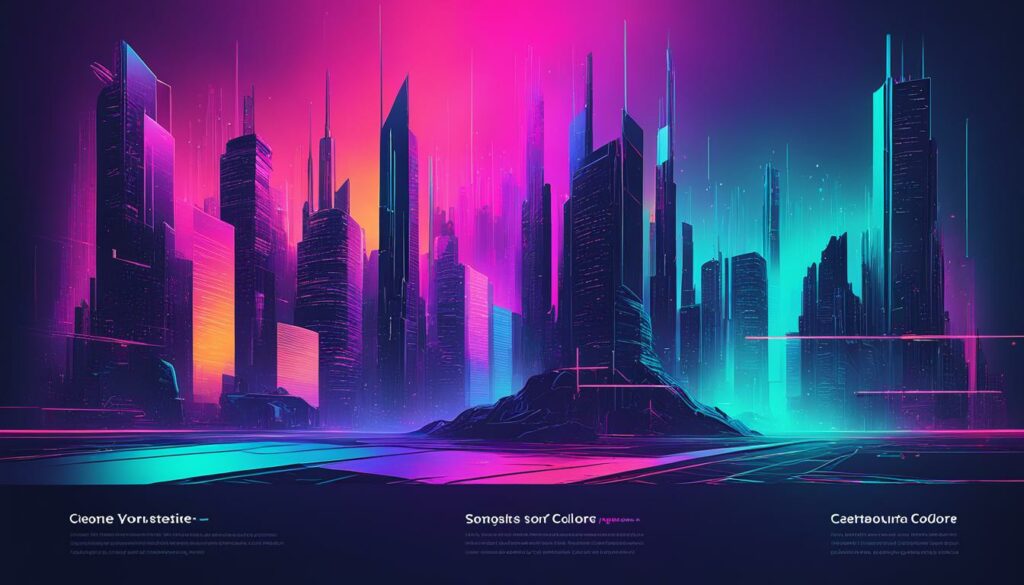Have you ever wondered why certain websites instantly capture your attention while others seem dull and unappealing? The secret lies in the power of color psychology in website design.
Color plays a crucial role in influencing user engagement, building brand trust, and ultimately shaping the success of a website. In fact, studies show that color can be up to 85% of the reason people decide to buy from a company. But how exactly does color affect our emotions and perceptions, and how can we use this knowledge to create compelling website designs?
In this article, we will explore the meanings associated with each color, delve into the psychology behind color choices in different industries, discuss the influence of color on user behavior, and provide practical tips for creating effective color schemes in website design. By the end, you’ll have a deeper understanding of how color psychology can be leveraged to create visually appealing and impactful websites.
Key Takeaways:
- Color plays a significant role in website design, influencing user engagement and brand perception.
- Each color has specific meanings and can evoke certain emotions and attitudes.
- Different industries have recommended colors that align with their brand image and target audience.
- Color can influence user behavior and guide them towards specific actions on a website.
- Choosing the right color scheme and strategically using colors in different areas of a website can enhance the overall user experience.
The Meanings Associated with Each Color
Different colors have different meanings and can evoke specific emotions and attitudes. Understanding the significance of each color in design can help you make informed decisions when choosing the color scheme for your website.
Blue: Associated with trust and often used by banks to convey reliability and security.
Red: Recommended for brands involving dating services as it symbolizes passion and excitement.
Yellow: Fun and playful, but be cautious as using too much yellow can become overwhelming.
Green: Associated with nature and being environmentally friendly, making it a popular choice across industries.
Orange: Energetic and enthusiastic, but can be polarizing and evoke strong reactions.
White: Conveys a sense of freedom and provides visual breathing room, often associated with simplicity and cleanliness.
Black: Commonly used but has conflicting associations – elegance and sophistication, as well as darkness and mystery.
Purple: Combines the power of red and the stability of blue, often chosen by luxury brands to represent creativity and exclusivity.
Pink: Associated with femininity and softness, often used in designs targeting female audiences.
Brown: The least popular color for web design, it can evoke a sense of reliability and dependability, but can also be perceived as dull or outdated.
Understanding the meanings and symbolism behind each color empowers you to make deliberate choices that align with your brand values and the emotions you want to evoke in your website visitors.
Recommended Colors for Different Industries
While it’s important to stand out from competitors, using colors that align with your industry can help create a consistent and cohesive brand image. Here are some recommended colors for different industries:
| Industry | Recommended Colors |
|---|---|
| Medicine, Science, Utilities, Government, Healthcare, Recruitment | Blue |
| Medicine, Science, Government, Tourism | Green |
| Construction, Corporate, Oil, Finance, Fashion | Black |
| Fashion, Makeup, Food, Dating, Video Games, Retail, Automotive, Hardware, Video Streaming | Red |
| Drinks, Retail, Fitness | Orange |
| Automotive, Retail, Food, Technology, Construction | Yellow |
| Medical, Food, Cosmetics, Retail | Pink |
Remember, these recommendations are not meant to limit your color choices but rather to help you create a strong brand presence within your industry.
Using color psychology in website design can be a powerful tool in creating a visually compelling and effective online presence. By understanding the psychology of color and utilizing the right colors in your website design, you can evoke specific emotions, influence user behavior, and ultimately drive desired actions from your target audience.
The Influence of Color on User Behavior
Color plays a crucial role in influencing user behavior and driving website conversions. In fact, within just 90 seconds, users decide whether they like a product, and a staggering 90% of that decision is based on color. The emotional impact of colors is significant, as each color elicits specific emotions and reactions from users.
- Red: Creates a sense of urgency and excitement.
- Blue: Evokes calmness and trust.
- Yellow: Promotes cheerfulness and optimism.
- Green: Conveys relaxation and harmony.
- Orange: Creates enthusiasm and energy.
- Purple: Represents luxury and creativity.
- Black: Evokes sophistication and elegance.
- White: Symbolizes purity and cleanliness.
Understanding the psychological effects of colors can greatly assist in designing websites that effectively engage users and guide them towards specific actions. By strategically utilizing color psychology in website design, you can create visually appealing designs that captivate users and drive desired outcomes. Now, let’s explore how to create an effective color scheme to further enhance user experience and convey your brand message.

Creating an Effective Color Scheme
Choosing the right color scheme is crucial for creating an effective website design. Understanding color harmony basics can help in selecting colors that work well together. Here are some popular color schemes to consider:
Complementary Color Scheme
Use opposite colors on the color wheel for a powerful contrast. This scheme creates visually striking designs and can be used to highlight specific elements on your website.
Monochromatic Color Scheme
Utilize various shades of the same color for a subtle and sophisticated look. This scheme is great for creating a harmonious and cohesive design.
Analogous Color Scheme
Combine adjacent colors on the color wheel for a comfortable design. This scheme creates a sense of harmony and is often used in nature-inspired designs.
Split-Complement Color Scheme
Select a color and the two adjacent tertiary colors of its complement for a balanced and visually appealing design. This scheme offers a unique combination of colors for a vibrant look.
Triadic Color Scheme
Choose three evenly spaced colors on the color wheel to create a balanced and dynamic design. This scheme provides a playful and energetic aesthetic.
Tetradic Color Scheme
Use two complementary pairs and select one color as the dominant. This scheme offers a wide range of colors and allows for creative exploration in the design process.
When creating your color scheme, pay attention to color value and saturation. Adjusting these factors can further enhance the overall design and create the desired visual impact.

Consider the harmony and contrast of your chosen colors to ensure a visually appealing and engaging website design that aligns with your brand identity and resonates with your target audience.
Areas to Use Colors in Website Design
When it comes to website design, colors can be powerful tools for conveying specific messages and eliciting desired responses from your audience. By strategically using color psychology in different areas of your website, you can capture attention, convey emotions, and guide users towards specific actions. Here are some key areas where color can make a significant impact:
- Pop-ups: Colors can be used in pop-ups to grab users’ attention and convey a sense of urgency or importance.
- Borders: Adding colored borders to elements on your website can help create visual distinction and draw users’ eyes to specific sections.
- Headlines: Using color psychology in your headlines can evoke certain emotions and make your content more engaging.
- Background hues: The background color of your website can set the overall tone and mood for your content, influencing how users perceive your brand.
- Primary web banners or hero graphics: The colors used in your web banners or hero graphics can immediately capture users’ attention and create a memorable impression.
- Buttons (especially calls to action): Color plays a critical role in buttons, particularly with calls to action. The right color can entice users to click and take the desired action.
- Other prominent areas: Consider using colors strategically in other prominent areas of your website, such as navigation menus, pricing tables, testimonials, and product listings.
By carefully selecting the appropriate colors for each of these areas, you can create a visually appealing and cohesive website design that effectively communicates your brand message and influences user behavior.

The Influence of Colors in Website Design
| Area | Color Psychology |
|---|---|
| Pop-ups | Grab attention and convey urgency or importance |
| Borders | Create visual distinction and draw focus to specific sections |
| Headlines | Evoke emotions and make content more engaging |
| Background hues | Set the overall tone and mood for the website |
| Primary web banners or hero graphics | Capture users’ attention and create a memorable impression |
| Buttons (especially calls to action) | Entice users to click and take desired actions |
| Other prominent areas | Strategically use colors in navigation menus, pricing tables, testimonials, and product listings |
Conclusion
Color psychology plays a significant role in website design, influencing user behavior and shaping brand identity. By understanding the meanings associated with different colors and considering industry recommendations, web designers can create visually appealing designs that engage users and convey the desired brand message.
The psychology of color in branding is crucial for building brand trust and creating a cohesive brand image. Different industries have different color preferences, and while it’s important to stand out, using colors that are commonly associated with the industry can create a sense of familiarity and credibility.
Furthermore, the emotional impact of colors on users should not be overlooked. Colors can evoke specific emotions and attitudes, influencing how users perceive a website and making them more likely to engage with the content or take desired actions.
In summary, incorporating color psychology in design is an essential aspect of creating effective websites. By understanding the psychology of color, considering industry recommendations, and utilizing color symbolism in design, web designers can create visually compelling websites that capture the attention of users, build brand trust, and drive desired actions.
FAQ
Q: How does color psychology impact website design?
A: Color psychology plays a significant role in website design by influencing user engagement, building brand trust, and shaping the success of a website. Different colors evoke specific emotions and attitudes, which can ultimately impact user behavior and website conversions.
Q: What are the meanings associated with each color?
A: Each color has different meanings and can evoke specific emotions. For example, blue is associated with trust, red with excitement, yellow with playfulness, green with nature, orange with enthusiasm, white with freedom, black with sophistication, purple with luxury, pink with femininity, and brown is the least popular color for web design.
Q: What are the recommended colors for different industries?
A: Different colors work well within specific industries. For example, blue is commonly used in medicine, science, utilities, government, healthcare, and recruitment, while black is suitable for construction, corporate, oil, finance, and fashion. Understanding industry recommendations helps create a consistent brand image within the industry.
Q: How does color influence user behavior?
A: Color can elicit specific emotions and reactions from users. Red can create urgency and excitement, while blue can evoke calmness and trust. Yellow promotes cheerfulness and optimism, green conveys relaxation and harmony, orange creates enthusiasm and energy, purple represents luxury and creativity, black evokes sophistication and elegance, and white symbolizes purity and cleanliness. Understanding the psychological effects of color can guide users towards specific actions.
Q: How can I create an effective color scheme?
A: Understanding color harmony basics is crucial. Complementary color schemes provide a powerful contrast, monochromatic color schemes offer a subtle and sophisticated look, analogous color schemes create comfortable designs, split-complement schemes provide harmony, triadic color schemes offer balance, and tetradic color schemes use two complementary pairs. Paying attention to color value and saturation enhances the overall design.
Q: Where should I use colors in website design?
A: Colors can be strategically used in various areas of website design to capture attention, convey emotions, and guide users towards specific actions. Consider using colors in pop-ups, borders, headlines, background hues, primary web banners or hero graphics, buttons (especially calls to action), and other prominent areas to create a visually engaging and cohesive design.
Q: How does color psychology impact website design overall?
A: Color psychology, with its meanings associated with different colors, industry recommendations, and impact on user behavior, all contribute to the success of a website. By understanding and utilizing color psychology effectively, web designers can create visually appealing designs that engage users and drive desired actions, enhancing the overall user experience and conveying the desired brand message.












